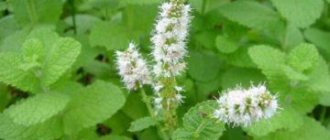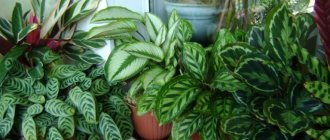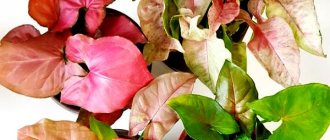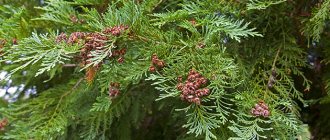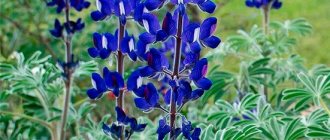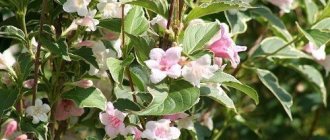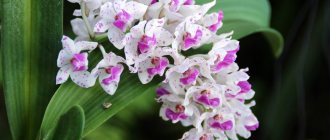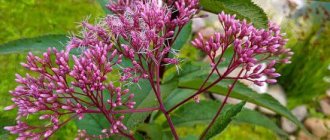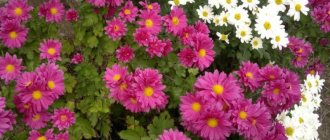Plant varieties
Unpretentious, medicinal and aromatic mint grows in every garden and is often found in natural conditions. This perennial herb belongs to the Lamiaceae family and has more than twenty-five varieties. The most common types are the following:
- pepper (English) - cultivated for use in medicine, cooking, and in everyday life;
- longifolia - grown on plantations to obtain essential oil;
- meadow - a wild plant that can often be found in gardens;
- curly - has a delicate aroma and the absence of a sharp cooling taste;
- Japanese - distinguished by large purple flowers.
Different types of this plant have differences in their composition, but all of them can be used for treatment and in cooking. Catnip (catnip) and its lemon scent are special. Catnip is unique in that it is very attractive to cats (including large predators). This herb is widely used in cooking, perfumery, and medicine.
Water
Perennial herbaceous plant. The stems are hairy, tetrahedral, and often creeping. The leaves are oval along the edge, serrate, up to 6 centimeters in length, sometimes reddish, more often green, with a pungent aroma of bergamot. The flowers are very small, light lilac, collected in small fluffy inflorescences. It usually blooms in July.
What is made from mint?
It’s easier to say what they don’t make from it - enter any hypermarket, and this plant and its derivatives will literally surround you. Fresh herbs, mint syrup, chewing gum, toothpaste, deodorant, shampoo, dishwashing liquid, tea mixtures with mint, dried herbs in the spices section, semi-finished lamb fillet in mint marinade, mint gingerbread, candy, and for fans of bad habits - mint liquor and menthol cigarettes. The situation is the same in the pharmacy: peppermint tincture, herbal infusions, cough drops, dandruff remedies - and this is not a complete list.
In cooking, mint is used mainly in fresh and dried form - both for flavoring dishes and giving food certain flavor shades, and simply for decoration, like any other greens. The easiest way is to brew mint tea - read more about the benefits and harms of this drink below. Perfumers also love to use mint - from its primitive use in household chemicals, where mint fragrance can qualitatively cancel out the not always pleasant original odors of substances in gels and aerosols, to the high art of composing fashionable fragrances.
Varieties for home
Types of plants that can be grown at home on windowsills or in greenhouses.
Home (Plectranthus or Spurflower)
The indoor plant is represented by several species, but all of them have strongly branching stems and closely growing leaves of light or dark green color. The leaf blades are oval, with carved edges. During the flowering period, corollas appear, the color of which depends on the species - blue, blue, white or lilac. The aroma is close to mint.
Plant grown in a pot
Chocolate
It was bred by Dutch breeders, and its distinctive feature is the aroma of chocolate and a brown tint on the leaves. The smooth stem can grow up to 50-60 cm. The shape of the leaves is semicircular, elongated, slightly corrugated and with veins. Small purple flowers are collected in inflorescences, in the place of which black mint seeds are formed.
Chocolate mint has brownish-purple leaves.
Additional Information! You can feel the chocolate aroma well from the leaves located in front of the inflorescences.
Ginger
This is a mint herb with wide, pointed green leaves with yellow veins growing on straight stems. It blooms with pink or purple flowers that gather in spikelets. This type does not contain menthol.
Can be grown on the window and balcony, planted in small pots or containers in the spring. She loves loose, fertile soil. It can be propagated by seeds, cuttings or dividing bushes. To grow, you need good lighting and a warm climate. All varieties of mint love plenty of watering and spraying.
Flea
perennial herbaceous plant
family Lamiaceae.
The stem is erect, branched, 20-60 centimeters high. The leaves are oblong, elliptical, wedge-shaped at the base, serrated along the edge. The flowers are small , collected in thick spherical rings, the corolla is pink-purple with a white tube. Blooms in July-August. It grows in floodplain meadows, along river banks in the western regions of Ukraine, in the south of the Caucasus, and in Central Asia.
Types of mint, photos with names of varieties
All studied species of this plant have an aroma unique to it. Mint is unique, since all its varieties are actively grown and used in various areas of life. There are many types of menthol herb, the most popular varieties are provided below, photos of the plant will help you see them clearly.
The British developed this variety of herb by crossing three species: spike grass, water grass and wild grass. The plant is not at all whimsical, but it begins to develop poorly when there is an abundance of weeds. After 3 years, the shrubs need to be replanted, as they age and lose their attractive decorative appearance. During the flowering period, it is an excellent honey plant. The plant contains about 4.5% menthol oil, which is widely used in medicine and cosmetology.
This variety is also commonly known as flea mint. It can be found in large quantities in Russia, the Caucasus and Ukraine. It reaches a height of up to 50 cm; oblong leaves are located on the branched shoot. Flowering begins in July and ends in mid-September. The inflorescences are collected in dense rings located around the shoot. The leaves of the plant contain 2% menthol. Dry leaves and stems are used as a seasoning in cooking, and it is also included in medicines.
House herb is one of the most common indoor plants. It has the same aroma and beneficial properties as all other members of this family. The spicy plant is unpretentious and grows well in a home pot. It releases essential oils that repel a variety of insects. It can be used for making tea, dessert and other dishes.
This medicinal herb is popularly known as lemon balm or honey mint. It blooms throughout the summer, and its aroma attracts bees, so mint is an excellent honey plant. This variety contains unique essential oils that are widely used in medicine. Melissa is unpretentious, it tolerates cold well and does not require additional fertilizer. The height of the stems can reach more than a meter. The spicy plant is valued for its aroma and excellent taste, which is why it is widely used in cooking. Lemon balm is widely used in cosmetology and medicine.
This variety is a representative of peppermint. A distinctive feature is considered to be a more pronounced and rich aroma of menthol. The height of the stems exceeds 50 cm; elongated leaves are located along it. Menthol mint is resistant to a variety of pests and diseases, so it grows well. It is often used for cosmetic purposes, for cooking, as well as in folk and traditional medicine.
It is better to collect the spicy plant outside the city, where it is environmentally friendly. Many people specially plant it on their plots so that later it can be harvested. Any variety of mint must be collected during active flowering. During this period, it is filled with essential oils and beneficial components. Cut the stems and lay them out in the fresh air, under a canopy, to dry. Dry raw materials are crushed and placed in a glass jar, tightly closed with a lid. The medicinal herb must be stored in a dark place.
The medicinal plant can be frozen. An instant decrease in temperature will preserve all the essential substances and beneficial components of mint.
A little history
The history of mint goes back to past centuries, where its study became a discovery for humanity. The spicy-fragrant plant has more than 10 varieties and it originated from more than one continent. It is known that the plant grows in different climacteric zones and territories of the globe.
For example: mint grew in Egypt, the Mediterranean Sea, China, England and Greece. The study of mint first began to appear in Ancient Greece, where the name “Menthe” - “Mint” from the ancient Greek language - came from. The Greeks considered the fragrant plant a real deity and used it in various cults.
Sweet mint has found very wide application for various ailments. This plant helped improve mood, body tone, digestion and refreshed the mind well. The process of rubbing the walls and corners of the house with fresh mint became a traditional cult among the Romans.
This ritual was performed to receive guests into the house and visitors to churches. The Chinese also idolized mint due to the healing properties of this plant. Particular attention was paid to its calming and relaxing properties. Currently, mint is found almost throughout the globe.
Its most common type is considered to be “Peppermint”, which is also found in Russia. It is worth noting about the varieties of this healing plant. Many varieties are divided into different categories and are used for specific areas.
There are individual medicinal varieties of mint for making medicines. Also, other varieties are intended as fragrant additives and esters for cosmetic and hygiene lines.
But some varieties are medicinal as drinks and food seasonings. To study a particular variety, it is worth familiarizing yourself with all varieties of a given plant.
Catnip photo
Another name for this plant is catnip. It has a lemon scent and attracts cats. For people in magic, the grass attracts love and courage. The plant is used to create pharmaceutical gardens and rocky compositions. Catnip attracts with its decorative effect and long flowering. The plant loves moderate watering and does not tolerate stagnant water. It has no diseases or pests.
Second name: catnip
It got its name because of the thin lemon juice that attracts the active attention of cats.
In gardening it is cultivated as a decorative garden decoration. An erect shoot can reach 1 meter, quite fluffy (but not like the Korean one in the next photo). The leaves are triangular-ovate, sharp.
Used in cooking as a spice. Used in soap making and perfume industry. Widespread in medicine.
Refers to powerful antiseptic and cooling products. Prescribed for anemia, replenishes vitamin deficiency in the body.
Longifolia
Perennial tall soft fluffy herbaceous plant. The whole plant has a grayish tint. The stem is branched, erect, slightly pubescent, reaching a height of 120 centimeters. The leaves are sessile, lanceolate, ovate, up to 20 centimeters long. Contains vitamin C, succinic, citric and malic acids. Whorls of small light purple flowers are collected in dense cylindrical spikes. Blooms in June-August. Grows in Africa, Asia, throughout Europe, in the North Caucasus.
Mint varieties
All varieties of mint have differences in flowers, leaves, and household uses. The list below is useful for gardeners who have not yet decided exactly what kind of mint to grow.
Peppermint
Decoctions from this plant are drunk for inflammation of the gastrointestinal tract; they can also be used to treat thermal damage to the skin. Peppermint tea is used for headaches and respiratory infections.
In everyday life it is used in perfumery, soap making, and aromatization of cosmetic products.
Korean mint
- tetrahedral shoots;
- the leaves are long, palm-sized;
- the plates are round, elongated, jagged, light green.
This is a bush up to 1 m tall, with straight stems. The miniature flowers are white or tinged with blue and grow in a “spikelet.” Flowering continues all summer, seed fruits appear in September. The aroma has hints of anise.
Description of dognip with photo
The foliage is bright green, kidney-shaped in shape. The flowers are small, grow in bunches, and their hue is purple. Flowering begins in June and continues until mid-July, after which the plant bears small brown fruits (about 2 mm)
Longleaf mint
This plant reaches 80 cm in height, has a strong branched root and spreading shoots with 4 edges. The leaves grow on short petioles and are elongated. This variety begins to bloom in June and the process continues until October. The flowers are small, collected in bunches, forming a flower “spikelet”, tapering upward.
Cat mint
Decoctions and teas from the leaves of catnip basilio are used as a sedative, improve sleep and appetite, and stabilize mood.
Moroccan mint
The leaves are ovoid, sharp at the ends, light green. The flowers are white or pinkish, collected in bunches, and the flowering period lasts from mid-summer to August.
Horsemint
- straight;
- smooth;
- a little over half a meter in height.
They contain oval-shaped leaves opposite each other. The shoots are spreading, less often - ordinary, covered with fluff at the bottom. The leaf blades are located on the cuttings, elongated, tapering at the ends. The leaves themselves are folded, up to 4 cm in length. At the top they are light green, at the bottom the color becomes less rich, to gray.
Horehound bears fruit with small, lumpy seed nuts. The fruits are yellow, lumpy, and ripen from mid-summer to early autumn. Small whorl-shaped flowers are found among the leaves.
Ginger mint
It is popularly used as a medicine for inflammatory infections and gastrointestinal diseases. Has a calming effect. Shoots can reach 1 m, smooth, spreading, densely covered with leaves. The foliage grows on short cuttings, the blades are up to 8 cm long, the tips are sharp. The leaves are teardrop-shaped.
The plant is also grown as a decoration, since the fine mint has a bright range of shades of yellow and emerald. The flowers are small, collected in bunches, which create spikelets of a delicate lilac hue. Flowering continues from early summer to October. The plant practically does not produce fruit.
Mexican mint
- bright green;
- big size;
- in the form of a pointed drop.
A variety with dark purple flowers is often grown. They are collected in a spicate group.
Gardeners actively grow mint. This crop improves the appearance of the site, is pleasing to the eye, and is easy to care for. The beds of Chinese mint fill the air with a refreshing aroma, which is especially pleasant in the heat. Traditional medicine welcomes this plant, as does cooking - the crop can be used to prepare decoctions, teas, syrups and for confectionery purposes. Substances released by mint culture cleanse the air of toxins and harmful impurities and have a beneficial effect on the functioning of the body as a whole. Therefore, having decided to grow mint on his plot, the owner receives both a pleasant green decoration and a truly multifunctional useful product.
Sadovaya
Perennial herbaceous plant. The stem is annual, tetrahedral, 30 to 100 centimeters high. The leaves are oblong, ovate with pointed tips, smooth above, pubescent below. The flowers are small, purple in color. Flowering period from July to late summer. Grows in the south and southwest of Russia.
Origin and characteristics of the plant
Central Asia is considered the birthplace of the medicinal plant. The culture gained species diversity at the beginning of the 17th century thanks to English breeders. At this time, the fragrant perennial began to be cultivated on an industrial scale to obtain essential oil. Subsequently, various varieties of mint began to be grown on the territories of 5 continents. The shoots of the spicy culture are used in cooking, perfumery and medicine.
Botanical description
The aromatic plant belongs to the Yamnotaceae family. Mint bushes are formed by erect stems up to 1 meter high. The leaves have a pointed shape with a thickened base. The front side of the plate is painted a rich green color, the back is usually paler. The length of the leaves is 3-6 cm.
Annual mint stems are green or brown in color depending on the variety. The tops of the main and lateral shoots end in spike-shaped mint flowers, collected in false whorls.
The root system of the fragrant crop develops close to the surface of the earth. The branched, woody roots have thickenings, from which new shoots grow every year. Root buds begin to grow with the arrival of the first thaw at a temperature of +2-3°C.
Where does mint grow?
The medicinal perennial is cultivated on an industrial scale in more than 40 countries around the world. In Russia, the main part of mint plantings is located in the Krasnodar Territory. It is possible to grow the plant in sunny areas even in the northern regions of the European continent.
Regardless of the variety, mint prefers moist soil with close groundwater. Under natural conditions it grows in lowlands, swampy places, and near water bodies. Artificially bred varieties place more demands on the structure and composition of the soil.
Garden mint prefers loose, light, well-drained soil. Cultivation requires moderately fertile soil with weak acidity. A decrease in pH levels leads to a decrease in the aroma and amount of essential oil in the composition of the grass shoots. The perennial plant tolerates winter temperatures down to -15°C without shelter. But spring frosts pose a danger. Early seedlings die if the temperature drops below -5°C.
General information about mint
The perennial plant loves cultivated soils, grows in the shade or in sunny places, and is unpretentious. It does not require fertilizing; moderate watering is sufficient. All types and varieties of mint reproduce by growing roots, petioles, rooting leaves, and seeds. In garden plots, it is better to grow the plant in flowerpots or in a fenced area for roots.
Since the herb is used for culinary purposes, the above-ground parts of almost all varieties can be collected during the end of flowering. This is the moment when the plant has the highest concentration of essential oils. Store dried leaves and petioles in a glass container in a dark place. They are used as a seasoning for dishes and as one part of herbal tea.
Industrial cultivation of various types and varieties of mint allows the resulting essential menthol oils to be used in perfumery and medicine. The aroma of menthol calms and makes you concentrate.
Students in the Middle Ages were required to wear a mint wreath on their heads to improve brain activity. If you put a mint leaf in your wallet, you will make a profit. If you rub yourself with mint, the forest midges will fly around.
Peppermint is especially often used for medicinal purposes. The content of essential oils in the culture depends on the growth conditions. In warm regions it is more saturated with useful substances, and there it is cultivated on an industrial scale. The extracted oil contains a lot of menthol and other volatile ester derivatives. The varieties of mint, photos of which are presented, differ not only in the shape of the leaves and inflorescences, but also in the properties that make the culture necessary.
The use of mint is based on its beneficial effects on the human body:
- relieves inflammation in the respiratory tract;
- exhibits an antispasmodic effect;
- has an analgesic and antiseptic effect;
- relieves panic and discomfort.
Mint - types and varieties with descriptions and photos
There are many types of Mint that can be purchased from herbal centers and herbalists. A fragrant collection of, for example, six varieties of mint will add much more variety to your garden, as well as your food.
The taste and smell of the widespread mint (Mentha spicata) is associated with chewing gum.
All types of mint have the same cultivation requirements. All have spike-shaped inflorescences of small bluish-pink or purple flowers that bloom in late summer. Since the flowers are not very attractive, it is best to trim them with scissors to encourage foliage growth. Many varieties of Mint have been created, which are useful to get to know better.
Applemint (M. x rotundifolia) is also known as round-leaved mint and has hairy stems and rounded, wrinkled, hairy leaves.
It is sometimes called M. suaueolens. "Variegata" (variegated apple mint) is sometimes called pineapple mint. Its leaves are mottled with creamy white spots and speckles, and some leaves are sometimes almost completely white. The reference to the pineapple scent is somewhat controversial, but was probably made up to differentiate it from apple mint.
Apple mint, especially its variegated form, is a compact plant about 30cm tall, making it suitable for planting at the front of a border or in a container.
Foxtail mint (M. x villosa var. alopecuroides). Some consider it a hybrid of M. spicata and M. rotundifolia, since it has rather large, rounded, pubescent leaves without stems.
It is a vigorously growing plant that tolerates dry soil better than other types of mint. Although this plant is not popular commercially due to its rapid decline after harvest, it makes an excellent mint sauce.
Spearmints are hybrids with curly, wavy or curled leaves.
The curly leaves add nothing to the culinary properties of the mint, but they do add variety and impact to a garden's collection of mints.
Cologne mint (M. x piperita var. citrata) is an erect plant with thin, smooth leaves, purple shoots and flowers.
When exposed to full sun, mint produces a strong cologne aroma. The whole plant in the sun has a purple bloom, and in the shade its color becomes closer to copper. The plant is used as an aromatic herb in dry aromatic mixtures or for preparing drinks sweetened with honey. Its taste is not suitable for mint sauce.
Ginger mint (M. x gentiles) is similar in aroma to spearmint.
Leaves with short stalks are pointed at both ends. Its variegated form is grown more often and is easily recognized by the yellow stripes along the veins of the leaves.
Longleaf mint (M. longifolia) has grayish and heavily pubescent long leaves.
They smell slightly musty, so they are not recommended for use in cooking.
Peppermint (M. x piperita) has thin, pubescent leaves on stalks.
Two forms of the plant are widespread: black peppermint, with dark purple stems and leaves about 6 cm long, and white peppermint, lighter green and with leaves about 7.5 cm long. The distinct smell of peppermint cannot be confused with the smell of others species. Peppermint makes a delicious, refreshing tea.
Melissa
Perennial herbaceous, medicinal, honey plant. The stem is erect, tetrahedral, branched, pubescent, 30-120 centimeters high. The leaves are opposite, pubescent, the lower ones are heart-shaped, long-petiolate, serrate along the edges, the upper ones are oblong, toothed. The flowers are usually small, white or pink.
Mint propagation
The perennial herb belongs to the Lamiaceae family. It is so unpretentious that growing mint is not particularly difficult even for novice gardeners. It can be found in absolutely all countries with a temperate climate. You may ask: how to care for mint and what fertilizers to use? The plant does not need any specific care or feeding. It thrives in the sun and shade, loves moderate humidity and will be content with even occasional rain.
When it comes to propagating mint, cultivation is also not particularly challenging. All you need to do is plant at least one plant in your garden. The rest of the worries will be taken on by the roots, which grow very quickly.
This representative of the flora reproduces by cuttings and division of roots. Reproduction by leaves, which quickly take root in the soil, is also allowed. However, we strongly recommend fencing the area where the mint is growing. This is a necessary measure to prevent the roots of this plant from extending beyond the site. For this purpose, a sheet of slate or ordinary roofing material is buried in the ground. Already in the first year of planting, you can safely harvest the crop in the form of leaves.
We also recommend reading
- Landscape design of a small summer cottage
- What is a pergola - an arch, a canopy or a support?
Mint can be consumed in dried or fresh form. Like any other greens, mint is dried on separate saucers or trays. It is spread out in a thin layer and left for some time in a dark but well-ventilated room. For storage, it is best to use glass containers with a tight lid. Ceramic is also suitable.
Propagation of indoor plectranthus by cuttings
Indoor plectranthus is propagated by stem cuttings about 10 cm long, as well as by dividing the bush when planting. The cuttings take root well in water, then they are transplanted into small containers, usually several seedlings together. Roots in 2-3 weeks. More than one cuttings planted together will help produce a large, lush bush.
For example, such as in this photo - here is a picture of plectranthus, also known as indoor mint, in its prime:
Propagation by apical cuttings. In spring, plants are pruned by 50% of the total length of the shoot. It is worth pinching the top, which promotes branching, and new young shoots are formed. Weak branches need to be pruned as they appear, year-round.
What diseases does it help with?
It is consumed fresh (if possible), and dried is also widely used. Pharmacies stock essential oils, alcohol tinctures, dried herbs and other ready-made dosage forms. Peppermint is used in the treatment of gastrointestinal spasms, bronchitis, flatulence; it has a diuretic and choleretic effect.
The therapeutic properties of this plant help get rid of angina, nausea, headache, heartburn, nausea. As an external agent it is used for:
- treatment of dermatological diseases;
- improvement of facial skin;
- strengthening hair and fighting dandruff;
- it also helps reduce toothache.
Menthol has a strong sedative effect, but in certain cases it can harm sexual function.
Catnip is used as an anthelmintic for humans and cats. It is used for coughs, hysteria, and to improve appetite.
Menthol
A perennial herbaceous plant with a pronounced menthol taste and smell. The stem is ordinary, erect, tetrahedral, slightly pubescent, 60-120 centimeters high. The leaves are elliptical-shaped and medium long. The flowers are collected in false whorls of white and pink color. Blooms in June-August. It grows everywhere.
Mint harvesting and storage
Cutting young stems with leaves can be done when the plants reach a height of 10-12 cm. On adult plants, the foliage is removed before flowering. During this period, the leaves have the highest content of essential oils and other beneficial substances.
The cuttings are washed under running water, laid out in a thin layer on natural burlap or other moisture-absorbing material, you can use loose paper.
To ensure that the plants retain their color, they are dried in a dark, well-ventilated area. The material is constantly stirred and turned over to prevent it from becoming moldy.
When the leaves are well dried, the dried mint is stored in glass containers with a ground stopper or in bags made of natural fabric. Store in a dark, dry place.
Properly dried mint can be stored for 1-2 years and used as needed for making teas, drinks, as part of medicinal mixtures or as seasonings for first and second courses. To prolong the use of fresh leaves, they are frozen, stored in the refrigerator for some time and used when necessary.
Dear readers! Mint is very easy to grow. It does not require complex agricultural technology. By planting mint in your garden, you will always have an aromatic spice and medicinal material for the prevention and treatment of many diseases.
Apple
Perennial herbaceous
spicy aromatic plant in the form of a bush. The stem is 60-80 centimeters high, highly branched up to 90 centimeters wide. The leaves are very beautiful, large, velvety, round in shape with wrinkled edges and rough to the touch. The flowers are ordinary small lilac-pink. It blooms mainly in July depending on climatic conditions.
Mint for women and men
The benefits of mint for women have been tested and confirmed by many generations of women who have used the analgesic and sedative properties of this herb:
- to relieve pain during menstruation;
- to relieve symptoms of menopause;
- to reduce the manifestations of toxicosis during pregnancy;
- to reduce body hair growth.
Modern women have at their disposal an extensive list of medications for these purposes, but medicinal mint still does not lose popularity among the fair sex - after all, a natural remedy is always healthier than a synthetic one. In addition, this herb has become actively used by those who want to lose weight - since mint tea, due to its high content of essential oils, dulls the appetite and is not harmful to the female body even with constant use, it can be drunk generously while on a diet.
Another open question related to mint is its harm to men. There is an opinion that the use of this herb, affecting the level of male hormones, reduces libido, which the stronger sex usually fears like fire. However, it can be argued that the harm from mint for men is at least greatly exaggerated: some specific effects can only be noticed with abundant and systematic consumption of this herb and its derivatives. The only exception is when trying to wash other, more delicate areas with mint anti-dandruff shampoo. In this case, the effect is felt with lightning speed.
Growing mint in a summer cottage
Selecting a location
Mint is a very aggressive plant. Its root system can quickly fill a garden. Once you decide to grow mint in your garden, you need to take some measures to limit its spread.
It is better to fence the place allocated for mint with slate or other materials at a depth of at least 30-40 cm. Some gardeners advise growing mint in old boilings, buckets, pots, basins.
It is better to choose a sunny place. This promotes the formation of more essential oils. Mint does not tolerate flooding and develops well in neutral soil (acidity 6-7 units).
The prepared area is dug up in the fall (possibly in early spring) and leveled well. If necessary, apply nitrogen-phosphorus fertilizers (any available on the farm) at the rate of 1-2 level tablespoons per square meter. m area. If the area is fertile, there is no need to apply fertilizer.
Methods for propagating mint
Mint can be propagated in different ways, of which the most common are the following:
- seeds;
- dividing the rhizome;
- cuttings.
Experienced gardeners also use rooting of leaves or petioles. The last two methods cause certain difficulties for beginners, so we will focus on the first three methods.
When propagating by seeds , you need to take into account that mint seeds are very small. Sow seeds in the top 1 cm layer of prepared, moistened soil in the second half of April. Sown in summer and autumn, seedlings take root worse.
It is more practical to sow the seeds for seedlings and then plant the seedlings in open ground. Before planting, high-quality seedlings must have a developed root system, 2-3 pairs of leaves and a plant height of at least 5 cm. Planting is carried out in a row manner, leaving 15-20 cm between young seedlings in the row and up to 30-35 cm between rows.
Propagation by dividing the rhizome is most acceptable. Does not require special skills or time. In May, carefully dig up the rhizome with the above-ground mass. The rhizome is divided, depending on its size, into several parts so that each has at least 5-10 growth buds.
The prepared material is planted to a depth of 8-12 cm in an ordinary way. A distance of up to 15-20 cm is left in the row, and 30-35 cm between rows. First, humus or wood ash is added to each planting hole, which is immediately mixed with the soil. After planting, carefully water with warm water and mulch.
Propagation by cuttings is more often used when growing mint indoors and in warm southern regions. In the northern regions, especially when planted late, the cuttings do not have time to take root and may die with the onset of early cold weather.
Cuttings are cut from the top of adult plants 8-12 cm long. The cutting is lowered 1/3 into water and wait for roots to appear. To make roots appear faster, add “Kornevin” or “Heteroauxin” to the water.
Rooted plants are planted in flower pots of 3-5 pieces and exposed to diffused light (the sunny side windows are covered with paper). Keep the soil in the pot moist (not wet). Mint does not need additional fertilizing if the soil for planting was well fertilized or the planting was carried out in specially prepared soil (can be purchased at the store).
Mint can be successfully grown in a container. © Sunnysingh22
Features of caring for mint plantings
Mint does not require special care. In open ground, a bed of mint must be kept moist by watering through a fine sieve or spray bottle, especially while the plants are young with fragile stems.
Since watering is carried out at a small rate, the soil must be mulched with fine mulch (sand, ash, mature compost or humus mixed with soil can be used). With high humidity, mostly in shaded places, mint is often affected by fungal diseases and has a less pronounced aroma.
It is enough to fertilize mint once a year, preferably in the fall, in minimal doses (per 1 sq. m. 1-2 tablespoons of nitroammofoska or other complete fertilizer).
Mint plantings must be constantly weeded. To make the bushes compact and more leafy, the tops of young plants are pinched. This technique stops the growth of mint in height and helps to increase the bushiness of plants.
To prevent mint from growing, you need to thin out the beds in the fall, making room for young sprouts and replant them in a new place after 3-4-5 years.
In spring, mint bushes are pruned at the root (before the leaves bloom). After pruning, the bush rejuvenates, becomes more lush, and more young leafy shoots appear.
Beneficial features
The healing properties of mint help in the fight against many diseases, which has found application in the creation of medicines. The herb has bactericidal, antiseptic, antispasmodic and vasodilating effects. Due to the content of a lot of useful substances, mint cures ailments related to various organ systems:
- Digestive. The herb helps with nausea, belching, heartburn, flatulence, and cramps. Decoctions stimulate digestive processes and intestinal motility. It is advisable to use mint for metabolic disorders, problems with the gallbladder, and chronic cholecystitis.
- Blood. Medicines prepared at home improve blood circulation and relieve attacks of angina and hypertension.
- Nervous. Peppermint tea is indicated for insomnia, depression, stress, and neuralgia. Adding fragrant leaves to drinks reduces the intensity of migraines.
- Respiratory. The culture has an auxiliary effect in the case of respiratory diseases such as asthmatic bronchitis, sore throat, colds, alleviating the condition.
- Female genitalia. Relieves symptoms of menopause, cures inflammation of the genital organs. Weak tea with mint is indicated for pregnant women to lift their mood and relieve signs of toxicosis.
Areas of use:
- Perfumery. Peppermint ether is often included in perfumes.
- Pharmaceuticals. The extract and ether of the herb are a component of many mixtures, cough syrups, lozenges, and throat lozenges.
- Cooking. Main direction: drinks and desserts.
- Cosmetology. Due to its antiseptic properties, it is used in the manufacture of masks for acne and acne.
Before using mint for medicinal purposes, it is recommended to consult a specialist.
Benefits of mint tea for the body
Peppermint tea is beneficial for humans. The benefits are as follows:
- calms, relieves anxiety, improves sleep;
- activates brain activity;
- disinfects;
- relieves pain. Relieves headaches and joint pain. Reduces cold symptoms (nasal congestion, body temperature);
- reduces blood pressure;
- helps with diseases of the digestive system. Relieves stomach colic and nausea, reduces gas formation in the intestines;
- restores a weakened body;
- strengthens the immune system.
You should not drink mint tea if you have low blood pressure.
Drinking a drink with mint can also harm a person. Menthol in tea causes allergies. You should not drink tea with low blood pressure, it causes lethargy and dizziness. Contraindicated for those suffering from varicose veins and heartburn. Do not take for children under 5 years of age, pregnant or lactating women.
Lemon Balm
This variety also has the name lemon mint. Despite the fact that this herb belongs to the mint genus, it belongs to a completely different family. The plant got its name due to its pleasant and fresh lemon flavor, and most often it grows in southern Europe.
This type of plant is one of the most valuable. Mint received such recognition due to its high content of useful substances and vitamin C. The perennial plant blooms in the summer, and the fruits that form on it ripen by the autumn season.
The height of the bush reaches a maximum of 120 cm. The stems are quite straight. The leaves are slightly pubescent, egg-shaped, and dark green in color. During the flowering period, purple flowers form on the plant.
After flowering, the plant bears black fruits of a fairly large size; they will be suitable for sowing for several more years. This plant tolerates winter cold well, but for additional protection it is recommended to cover it with a layer of mulch.
What type of plant is best to add?
You can use any variety of mint; fortunately, there are a great many of them in our nature. The preferred and most common choice for tea is mint :
- pepper;
- lemon;
- wild;
- garden
Each of them carries various beneficial properties, and also differ in the quality and type of aroma emitted.
Tea with mint
Peppermint leaves can be used to make a wonderful soothing tea. One writer called this tea one of the best natural tonics. Peppermint is used in cooking and confectionery.
Since ancient times, various types of mint have been used in medicine, and now they occupy an important place in trade. Peppermint and spearmint are added to a huge number of products, from chewing gum to toothpastes.
Often, mint chooses sunny places with moist and moderately enriched soils as its habitat; sometimes mint can also grow in shade or partial shade. These plants reproduce underground using stems or shoots.
wild
Herbaceous perennial plant with a subtle fragrant menthol aroma. The stem is like that of ordinary peppermint, 15-100 high. The leaves are oblong, pointed, ovate with serrated edges. Flowers of a lilac or pinkish hue are collected in whorls. Blooms all summer and autumn from June to October. Grows throughout Russia.
Field mint
Widely used in folk medicine, cooking and perfumery. It differs from other species by the presence of tall, hairy stems of a reddish color. The flowers are violet or lilac in color, and after flowering, the fruits look like smooth nuts. The stems and leaves are considered beneficial. They are used to prepare teas and medicinal decoctions that are beneficial for the gastrointestinal tract.
Longleaf mint
A perennial herbaceous crop that also has a number of beneficial properties. A low shrub with gray-green leaves and branched stems. Small flowers of light lilac color form cylindrical spikes. Longleaf mint is rich in vitamin C and essential oils. The smell can lift your spirits, which is why it is used in perfumery. As a spice, you need to use stems picked before flowering, otherwise they will be very tough.
Ginger mint
It has another name: “Ginger”. Perennial variety with a light ginger aroma. The leaves are bright, yellow-green in color, and the stems reach 60 cm in length. It has a calming effect on the nervous system and is also used in cosmetology, medicine and cooking.
General information
There are many varieties of mint known to gardeners and food lovers, all slightly different in taste, aroma and appearance. In the family of Lamiaceae plants of the genus "Mint", there are up to 18 species. However, the largest group of plants in this family is actually the delicious sage, with its bright blue flowers, bitter taste and spicy aroma. Many other well-known herbs are also found in this family, including basil, thyme, lavender, and even skullcap. One of the characteristic features of plants in this family is that they all produce essential oils, giving each plant its own unique characteristics, increasing their potential for medicinal use.
Most mint species are low-growing perennials, but some are taller. The height range is from 10 cm to 1 meter, so not all of them are at ground level. It sends out individual shoots, which helps it spread by developing roots. In good conditions, this allows it to grow quickly. For most gardeners, one or two plants are enough to propagate them, as they all grow quickly. Some species can spread very quickly, so it is recommended that they be grown in containers or fenced with above-ground barriers, although this does not stop it from being a useful addition to your garden. Mint can be damaged by some pests such as snails and aphids.
Most of these plants have square stems, with leaves arranged in opposite pairs. They are often hairy with a jagged edge, with varying leaf shapes and colors ranging from green to purple. The flowers, as a rule, can be of different shades from white to purple, and are collected in whorls. The corolla is divided into two lips and has 4 petals, where the top one is usually the largest.
Mint grows in all corners of the globe and is suitable for most climates, including a wide range of areas throughout Australia. Some of the varieties are considered perennial, but in cold climates it is better to replace them every year. They generally require a lot of water and prefer rich soils. Due to the ideal conditions, mint is grown commercially in Tasmania as the high altitudes have long summer days where temperatures average 25°C during the day and up to 15°C at night. Ideal conditions typically require plenty of sun, but some shade won't hurt as temperatures can be high in warmer regions.
Water mint hybridizes very easily with other species, so there are many options to add variety to any garden. Therefore, if you plant several species, some of them will hybridize in your garden. However, many varieties, such as ginger mint, chocolate mint, and many others, then become clearly visible.
Cultivation care
In order for the spicy crop to be comfortable, it is fed every spring. Nitrogen-containing complexes or compost, humus, a solution of chicken or cow droppings are suitable as fertilizers.
The temperature in the open ground in summer is comfortable for the plant, but indoors in winter it is worth protecting it with a damper from hot heating radiators.
In summer, the spicy crop on the windowsill needs to be shaded in direct sunlight. In winter, on the contrary, mint should be illuminated with fluorescent lamps so that the daylight hours are at least 8 hours a day.
Watering the plant
Chocolate mint is demanding of soil moisture, so water it systematically as soon as it dries out. She also responds positively to spraying. This procedure helps maintain the necessary humidity and frees the surface of the plants from dust. After irrigation, the spicy crop becomes bright and well-groomed.
Mint grows well in areas with high dampness, which means it can be planted near bodies of water and in lowlands. The fact that the soil in these areas is highly acidic does not hinder the plant.
Spicy herbs in containers need to be well soaked. Excess moisture will be removed through the drainage holes. Next time, you should not allow the soil to dry out completely.
Weeding
Weeding should be done when the need arises. Without this action, the mint will gradually wither and disappear. A crop growing in a garden bed needs to be replanted every 3 years because it is attacked by weeds.
Loosening
Loosening the soil is also important for chocolate mint. It helps the plant roots receive more oxygen and retains most of the moisture.
Japanese
Perennial herbaceous plant. The stem is erect, less often creeping, 40 centimeters high. The leaves are small in length, barely reaching 2 centimeters. The flowers are small, white or lavender in color, collected in sparse inflorescences. Blooms in August. It grows only on two islands, Honshu and Hokkaido.
Compound
All species have a branched rhizome located shallow in the ground. The tetrahedral stems can reach a meter in height, and the oblong green leaves can have a purple hue. In the second half of summer, panicles of purple flowers open, and the seeds ripen by autumn. All parts of the herb contain tannins, bitterness, vitamins and other ingredients, the main one of which is essential oil.
The composition of the essential oil of different types of mint may differ. The medicinal properties of peppercorn are due to the fact that it contains menthol.
. This substance:
- has antiseptic and anesthetic properties;
- activates nerve receptors;
- causing a feeling of cold;
- dilates blood vessels;
- calms down.
Where is menthol used:
- It is part of many pharmaceuticals and is added to anti-burn and dental products, toothpastes, and cosmetic products.
- Preparations with menthol are used to increase blood pressure, as an antispasmodic agent for cramps and stomach cramps.
- Inhaling its vapors reduces coughing and has a calming effect in cases of increased nervousness and nausea.
- External use is effective for inflammation, excessive skin sensitivity, bacterial and fungal infections, and helps get rid of bruises and swelling.
Peppermint has the highest content of this substance, but curly mint contains practically none. Essential oils of catnip and lemon balm also do not contain menthol; they contain geraniol, citral, limonene and other components. In addition, the feline species contains nepectalone, as a result of which the plant produces a stimulating effect on cats, but does not cause them harm.
Is it possible to add flowers and not just leaves?
Mint is a storehouse of vitamins . Its stems, leaves and flowers contain:
- organic acids that normalize digestion;
- essential oil that has a lot of beneficial properties for our health - from calming to anti-inflammatory effects;
- tannins having antibacterial properties;
- provitamin A and much more.
From this we can conclude that you can brew tea with both mint leaves and flowers. And the presence of crushed stems in the teapot will not harm the body in any way.
